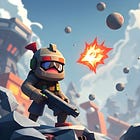34. Optimized Tribes vs. Sports Teams: Crafting the Future of Game Development
Discussion about different types of organizational cultures and how they fit for future game development
While I’ve been exploring ways for developing games more effectively, I’ve been following, and analyzing, throughout the past few years a lots of dynamical changes in the industry. Throughout these explorations, I’ve started not just on writing my blog on educating the industry over building better games, but also started exploring the depths of what actually is the way to build sustainable games (on top of what ingredients sustainable games should have in them).
In terms of “the way” of building sustainable games (and, indeed discussing what they should have in their DNA), I’ve explored (and written about) things like iterative development and safeguarding that properly from top to down (and vice versa), in a business environment for game development. These are important topics, and they have their place in building success within the industry — whilst, overall, everything on this front, in terms of how to build future-proven games, falls over the team and/or studio (and/or corporate) dynamics’ side and how effectively these dynamics are structured and working; and, this is where we’ll be focusing on this article, on top of opening a topic around how team and social dynamics can be used in game design as a side quest.
Note: As an inspiration for this article, one part of it comes from other writers’ blogs as an inspirational source. But, not all, as these are things that I’ve myself had to thought through in managing smaller and larger teams in the past, on top of which I’ve discussed on managing organizational dynamics and cultures with various companies’ leaders over past few years’ time to educate myself on these topics. In terms of the sources for my inspiration, you can find some of these blogs I mention from my recommendations list.
Side Note: This article is a follow-on article to my previous article where I explore principles and DNA for sustainable games (https://gamesalchemy.substack.com/p/32-future-principles-and-dna-for):
Family vs. Sports Team vs. Tribe
The evolution of game studios and development teams has long been shaped by different cultural paradigms.
Historically, many studios have embraced a "family culture" — a well-intended but often suboptimal approach when it comes to long-term performance, strategic decision-making (incl. all good and bad ones), and the ability to innovate at scale. While the values of camaraderie and support within a family dynamic are valuable, they can also lead to emotional decision-making, reluctance to challenge underperformance, and resistance to necessary structural changes. Family dynamics is not really the solution here, whilst my solution has some similarities on its good sides.
In terms of developing games more effective in the future, and instead of the family dynamics, we must consider alternative cultural frameworks that can help game studios thrive sustainably. On this front, in terms of how I perceive the current status quo vs. future game development; two models for structuring game development teams are optimized tribes and sports teams. In terms of how these are applied, what everyone can see now is that the sports team model / metaphor is referred most often by company leaders, meaning it’s commonly used and operated against on; but / however, as I analyze some of these companies, some of them actually (they know this, or not — who knows really) operate with tribe-like approaches over actual sports team-like approach, so tribes do also exists.
In terms of building sustainable games in the future, and while both offer valuable lessons; I believe that a properly optimized tribe, with a large world perception and a balance of performance-driven culture and exploratory thinking, presents a more sustainable and future-proven structure for game development in the future. Why and how? Let’s explore that below in comparing tribes against sports teams.
Note: Whilst I’m in this article educating my leaders over tribe and sports team models, I’m not against them — and could easily myself work within both types of cultures, as in both there are good sides that I also like in taking part in, as I can adapt myself pretty quickly to support these cultures and growth through them. My article here focuses on the future explorations over building truly sustainable and self-propagating games and businesses around them, where I think an optimized tribe model is better — whilst I also do acknowledge that you could build a sports team-like model over this type of vision and mission.
The Tribe Paradigm in Game Development
When we’re starting to explore tribes, they, in this context, do not refer to historical or anthropological definitions — but rather to an optimized framework that fosters strong cohesion, a shared mission, and adaptability while maintaining the rigor needed for long-term business success.
The key advantage of the tribe structure is its ability to be dynamic and to cultivate a certain sized worldview that aligns with its innovation, iterative mindset and sustainability in game development in connection with the tribe’s worldview’s size, which either enables or limits the tribe’s innovation, iterative mindset and sustainability levels in game game development (in this particular context we’re referencing to status quo / what’s working vs. risk-taking on future explorations and innovations). I’m opening this more below.
The Impact of Worldview on Game Development
Tribes can be categorized based on their perception of the world to small worldview tribes and large worldview tribes:
Small Worldview Tribes: These teams often focus on efficiency, known formulas, and iterative improvements on existing concepts. They are commonly found in hit-driven game markets like hypercasual and hybrid casual, where success is based on optimizing a rapid experimentation and failure cycle, often with a “1-out-of-10” or higher / lower success rate (depending on how far scientific methods are built).
Large Worldview Tribes: These teams are more exploratory, drawing from diverse perspectives (diversity on this front means diversity regarding work history, background, and individuals’ perception of the world as well as game development, incl. bringing new and fresh formulas to it to extend the tribe’s world perception), cultural insights, and business strategies. They strive to focus on both sides — working formulas they have discovered as well as on innovative experiences aligned with some of more of the identified future principles and DNA for sustainable games, which I’ve written about previously about (link to this article can be found above from this article). These tribes create titles that e.g., push boundaries in gameplay, monetization, and player engagement.
The Business Optimization of Tribes
A well-optimized tribe balances both business performance and cultural depth:
Small Worldview Tribes: Operate with a narrow focus, excelling in specialized game segments. They drive performance but may struggle with adaptability and broader innovation.
Large Worldview Tribes: Are optimized for vision-driven exploration, balancing high performance with mission-driven sustainability. These are the ideal structures for long-term success in an evolving game industry.
By cultivating large worldview tribes, studios can create an environment where performance and innovation coexist, allowing for deep explorations into new game models, emergent player-driven experiences, and truly sustainable gaming ecosystems.
The Sports Team Metaphor: Strengths and Limitations
Sports teams share some similarities with tribes but operate with a distinct philosophy. While optimized for high performance, they may lack the cultural and exploratory strengths of an optimized tribe — because, overall (which also can be a good thing for certain businesses), sports teams focus on being best in their sport (which also has clear but limited focus on that “one sport”).
(Ineffective; in the Context of Building Sustainable Games) Characteristics of Sports Teams in a Game Development Context
Specialization: Sports teams excel in their field but do not necessarily explore beyond it. This approach can work well in hyper-focused game markets (again, hypercasual and hybrid casual segments), where precise execution matters more than long-term strategic adaptability.
Performance-Based Optimizations: Low performers are often removed quickly, which can maintain efficiency but may lead to instability in high-risk, long-cycle game development projects.
While sports team dynamics can be useful for some duration and optimizing results-driven environments (such as live ops’ extrinsic / full-commercial optimization or rapid prototyping teams), they can be still less suited for building games that require a long-term vision, strategic adaptability, and deep innovation. A purely sports-team approach can also lead to competition over resources, decision-making bottlenecks, and misaligned incentives — especially in large organizations.
Note: Again, I’m not against sports teams but in the context of building sustainable games future-proven games, it might not be the most optimal choice for that, which I’m aiming to educate my readers on about it.
The Future: Large Worldview Tribes as the Optimal Structure for Game Studios
While both optimized tribes and sports teams offer strengths, I believe that the future of sustainable game development lies in an optimized and large worldview tribes. These teams cultivate exploration, foster deep expertise, and align with the principles of innovation, adaptability, and long-term viability (and, as applicable; align with things outlined in the future DNA for sustainable games article as well).
By embracing an optimized tribe-first approach, studios can create a high-performance yet adaptive and culturally rich environment — one that balances mission-driven creativity with business success. The future of game development demands nothing less.
Note: Want to make your worldview even larger? Consider cross-pollination, about which I’ve wrote more here (https://gamesalchemy.substack.com/p/36-cross-pollination-a-potential):
Extra Read: Applying Tribe and Sports Team Thinking to Game Design, Economy, and Monetization
Did you know that the tribe and sports team metaphors also apply to game design, economy design, and monetization (if not, well now you know, at least a bit)? Here’s how they can applied:
Social Gameplay: Players can be embedded into game dynamics that mimic tribes (collaborative, evolving experiences) or sports teams (competitive, structured / straight-forward gameplay).
UGC Influence: Even without full UGC, character development and world evolution can create emergent gameplay where players shape the game ecosystem.
Monetization Strategies: Games with tribal social group monetization emphasize long-term intrinsic value, whereas in some cases (not in all, if you build this in healthy way) sports-like monetization aligns more with extrinsic, achievement-driven spending.
I explore some of these layers in my articles here:









